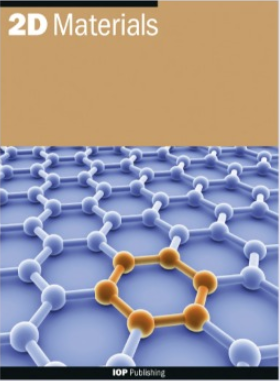WSe2单层中金属-纳米粒子诱导单光子发射体的温度相关时间相干性
IF 4.3
3区 材料科学
Q2 MATERIALS SCIENCE, MULTIDISCIPLINARY
引用次数: 0
摘要
近年来,人们对二维材料作为高光学质量和量子光学质量的单光子源的适用性进行了大量的研究。其中,过渡金属二硫族化合物,尤其是wse2,一直是人们研究的热点之一。然而,它们的单光子纯度和光子不可分辨性仍然是与成熟半导体系统(如自组装InGaAs量子点)竞争的最大挑战。在这项工作中,我们探索了金属纳米颗粒诱导的二氧化硅单层中量子发射体的发射特性。在准共振脉冲激励下,我们验证了干净的单光子发射,g(2)(0) = 0.036±0.004。此外,我们通过迈克尔逊干涉测量法确定了温度相关相干时间,其中零声子线在4 K时提取的值为(13.5±1.0)ps,在8 K时减少到(9±2)ps。相关的时间分辨光致发光实验表明,衰减时间从(2.4±0.1)ns减少到(0.42±0.05)ns。这种衰减时间的变化可以用一个模型来解释,该模型考虑了Förster-type共振能量转移过程,该过程产生了从单光子发射器到附近银纳米粒子的强烈温度诱导能量损失。本文章由计算机程序翻译,如有差异,请以英文原文为准。
Temperature dependent temporal coherence of metallic-nanoparticle-induced single-photon emitters in a WSe2 monolayer
Abstract In recent years, much research has been undertaken to investigate the suitability of two-dimensional materials to act as single-photon sources with high optical and quantum optical quality. Amongst them, transition-metal dichalcogenides, especially WSe 2 , have been one of the subjects of intensive studies. Yet, their single-photon purity and photon indistinguishability remain the most significant challenges to compete with mature semiconducting systems such as self-assembled InGaAs quantum dots. In this work, we explore the emission properties of quantum emitters in a WSe 2 monolayer which are induced by metallic nanoparticles. Under quasi-resonant pulsed excitation, we verify clean single-photon emission with a g (2) (0) = 0.036 ± 0.004. Furthermore, we determine the temperature dependent coherence time via Michelson interferometry, where a value of (13.5 ± 1.0) ps is extracted for the zero-phonon line at 4 K, which reduces to (9 ± 2) ps at 8 K. Associated time-resolved photoluminescence experiments reveal a decrease of the decay time from (2.4 ± 0.1) ns to (0.42 ± 0.05) ns. This change in decay time is explained by a model which considers a Förster-type resonant energy transfer process which yields a strong temperature induced energy loss from the single-photon emitters to the nearby Ag nanoparticle.
求助全文
通过发布文献求助,成功后即可免费获取论文全文。
去求助
来源期刊

2D Materials
MATERIALS SCIENCE, MULTIDISCIPLINARY-
CiteScore
10.70
自引率
5.50%
发文量
138
审稿时长
1.5 months
期刊介绍:
2D Materials is a multidisciplinary, electronic-only journal devoted to publishing fundamental and applied research of the highest quality and impact covering all aspects of graphene and related two-dimensional materials.
 求助内容:
求助内容: 应助结果提醒方式:
应助结果提醒方式:


